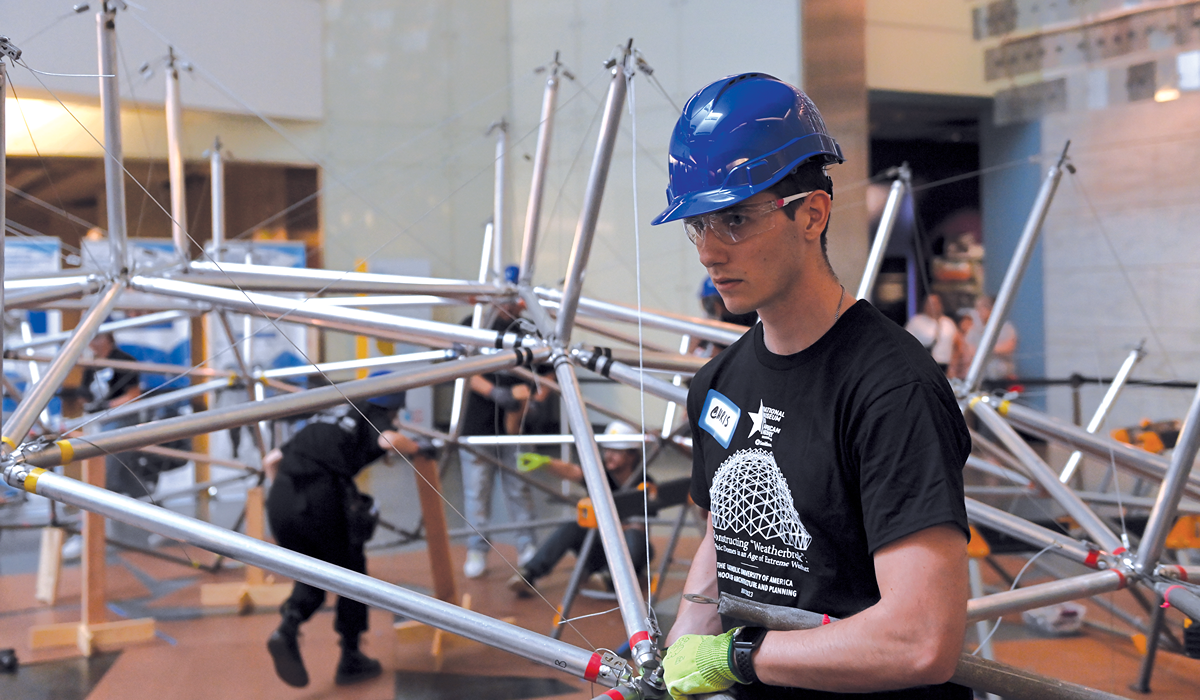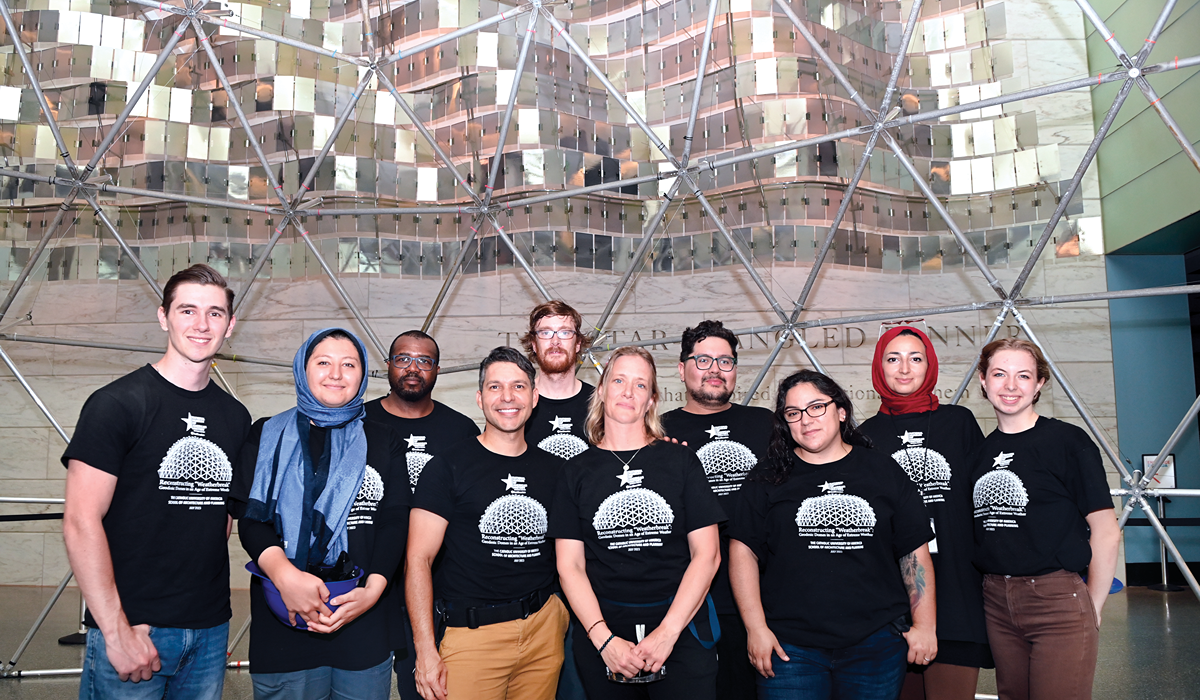

Chris Castrogiovanni, M.Arch. candidate, leaned in as he carefully fit together 70-year-old metal rods, or struts, from one of the first large-scale, self-supporting geodesic domes in the world and the first in North America.
The dome had been in storage since being gifted to the Smithsonian in the 1970s. At 2,000 square feet, and 49 feet wide by 25 feet high, the building is slightly smaller than today’s average U.S. home.
Originally built in Montreal in 1950 and later rebuilt in the Hollywood Hills as a home for architect Bernard Judge, the structure was reconstructed inside the iconic Flag Hall of the National Museum of American History, July 5 to 7, through a partnership between the museum and Catholic University’s School of Architecture and Planning.
Nearly a year earlier Abeer Saha, curator with the museum’s Division of Work and Industry, contacted Tonya Ohnstad, assistant professor of architecture and associate dean for graduate studies, with a rare opportunity for students to engage hands-on with a historic artifact. The result was the exhibit “Reconstructing Weatherbreak: Geodesic Domes in an Age of Extreme Weather.”
Inspired by the theories of inventor and futurist Buckminster Fuller, architect Jeffrey Lindsay had designed Weatherbreak as a lightweight, stable structure that could resist extreme environmental weather, including winds up to 200 miles per hour.
Saha hoped the reconstruction would “convey that historical artifacts can inform our search for sustainable solutions in an age of climate change … at a time when more than 24 million people are displaced by extreme weather events worldwide each year.”
Ohnstad created a yearlong course around the reconstruction, overseeing student work with Lorenzo Cardim DeAlmeida, fabrication manager for the architecture school.
She also forged partnerships with Norsk Hydro, Architectural Systems, Inc., and DSI Spaceframes, companies that donated recycled aluminum and fabrication to replicate missing or broken parts, as well as a team from Washington University. Consigli Construction contributed financially.
“Working with iconic American objects like Weatherbreak is an honor. To bring it back to life in three dimensions so the public can understand its scale and the space it creates is humbling. Accessing this piece of history as a learning tool is a premier learning experience,” Ohnstad said.

For Castrogiovanni, the opportunity to work on Weatherbreak led him to choose Catholic University.
“(Tonya) mentioned this project. I was just hooked after that. That was one of the main reasons I chose this school for graduate school. It’s been a fantastic experience ever since,” he said, noting that he had studied Fuller’s groundbreaking work with dome structures while an undergraduate at Southern Illinois University where Fuller once served on the faculty.
The students quickly discovered that the reconstruction of the dome, the first time it would be put together in over 50 years, would be complex. Weatherbreak came with 1,000 metal struts in 16 lengths, some broken, and a single sheet of paper with a color code, but no instructions.
They researched geodesic domes, worked out mathematical calculations, developed scale models, and constructed two full-scale test models on campus in spring 2023, with professional fabricators traveling to Washington, D.C., to work alongside them.
“When we had to refabricate some of the pieces, I did the early drawings for (the engineers). We would go back and forth trying to perfect the new pieces,” Castrogiovanni said.

Catholic University President Peter K. Kilpatrick, himself an engineer, pointed out that “this collaboration (with the Smithsonian) not only showcases the expertise of our students, but also fosters a critical conversation about the utility of geodesic domes in the face of extreme weather challenges.”
In addition to withstanding hurricane-strength winds, these domes have been found to withstand stresses from earthquakes, are more energy efficient than conventional homes, and can be lightweight and portable.
The benefits interested curious visitors who stopped to watch the dome take shape and to ask questions. The project also drew the attention of the media, including The New York Times and The Weather Channel.
Michael Matthews, B.S.Arch. 2022, M.Arch. candidate, had a heavy course load, but became involved in the dome project through his interest in sacred architecture and the use of domes in church design. The Army veteran spent a semester at the University’s Rome campus in 2021.
Having worked on the models for Weatherbreak, he said, “It was truly amazing to see the dome standing after they removed all the supports.”
With the build behind them, University students finalized instructions and documentation that will remain with Weatherbreak as a permanent part of museum archives.
“I’m really honored to have been chosen to do this,” said Castrogiovanni. “It’s kind of surreal to have something in the museum that you’ve worked on, but having your name with it is incredible. It will forever be a part of the Smithsonian.”
— S.G.